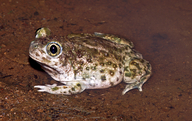|
Spea hammondii (Baird, 1859)
Western Spadefoot | family: Scaphiopodidae genus: Spea |
 © 2018 Chris Brown, USGS (1 of 72) |
|
|
|
Description Spea hammondii, the Western Spadefoot Toad, is medium-sized with adults reaching up to 65 mm in SVL. The skin is loose with small vertebral tubercles. The head is as wide as the body, having a rounded snout with an upward tilt and large protuberant eyes. The parotoid glands are small and not distinct. Forelimbs and hindlimbs are short and stout, with the foreleg having dorsal tubercles. The feet have well-developed webbing between the toes. The main distinguishing features are the single semicircular black "spade" (keratinized inner metatarsal tubercle) on each heel, and vertical pupils. The dorsal ground color ranges from light green to gray with scattered darker splotches. A pair of light-colored spots is generally present, one on each side of the anus. Body tubercles can be orange to somewhat red. Usually a pair of light-colored paravertebral stripes is present, extending from behind the eyes. Ventrally, the color is whitish to creamy-yellow. Distribution and Habitat Country distribution from AmphibiaWeb's database: Mexico, United States U.S. state distribution from AmphibiaWeb's database: California
Life History, Abundance, Activity, and Special Behaviors Outside of the mating season, Spea hammondii spend most of their time underground in their burrows. The Western spadefoots are mostly nocturnal creatures, but can be heard calling during the day following winter and spring rain. Mating occurs from late December to mid-May. Spadefoot toads are "explosive" breeders, taking rapid advantage of summer rains and ensuing temporary ponds to mate. Their mating call consists of a loud snore lasting 0.5 to 1 second, sounding like w-a-a-a or r-a-a-a-w. A single female can lay more than 600 eggs, attaching them to vegetation. Development can be extraordinarily rapid, with hatching occurring in as little as five days. Larva Possible reasons for amphibian decline General habitat alteration and loss Comments This species was featured as News of the Week on 20 July 2020: Habitat loss and degradation are the greatest causes of amphibian declines globally. A commonly proposed solution is to create artificial habitat – such as "mitigation" ponds - which can act as substitute habitat for amphibians displaced by habitat loss. But how well do they work? Baumberger et al. (2020) tested longterm success of created habitat by resurveying 21 mitigation ponds ten years post-construction and ten natural ponds impacted by urban development in southern California. They found that the artificial ponds maintained the adequate hydroperiod to sustain Western Spadefoot Toads (Spea hammondii), the species these ponds were targetting. Critically, western spadefoot larvae and embryos had been translocated to these ponds a decade earlier and many ponds still host populations which not only successfully breed but also metamorphose. These artificial habitats serve an important role because surveys found these toads are now entirely absent in the urban landscape they used to exist in. Given Western Spadefoot Toads are an IUCN Near-Threatened species, a California Species of Special Concern, and are under review for listing under the U.S. Endangered Species Act, knowing that created habitat is a successful conservation tool is critical for their conservation. Importantly, southern California is experiencing tremendous effects of climate change and these ponds were impacted by drought but provided western spadefoots a buffer against the effects of climate change. If designed correctly, artificial habitat can be a useful tool to buffer amphibian declines from both habitat loss and climate change (Written by Max Lambert). This species was featured as News of the Week on 29 January 2024: Animals that live underground have to deal with long periods with low oxygen and sometimes high carbon dioxide within burrows. Burrowing mammals often handle this challenge by having lower metabolisms than species that stay above ground. Many amphibians spend lots of time in burrows but it was not clear whether they had lower metabolisms like burrowing mammals. Giacometti and Tattersall (2023) compared metabolic rates among 185 amphibian species with different lifestyles including burrowing, but found that burrowing amphibians did not have lower metabolic rates than non-burrowing amphibians. Instead, they found that species living at higher latitudes generally had higher metabolic rates than species at lower latitudes, regardless of lifestyle. It is possible that having relatively low energy requirements, small body sizes, and multiple respiratory surfaces (skin and lungs) helps amphibians avoid negative respiratory effects of life underground. (Written by Molly Womack)
References
Grismer, L. L. (2002). Amphibians and Reptiles of Baja California. University of California Press, Berkeley. Originally submitted by: Peera Chantasirivisal (first posted 2005-10-11) Edited by: Kellie Whittaker, Michelle S. Koo, Ann T. Chang (2024-01-28) Species Account Citation: AmphibiaWeb 2024 Spea hammondii: Western Spadefoot <https://amphibiaweb.org/species/5279> University of California, Berkeley, CA, USA. Accessed May 19, 2025.
Feedback or comments about this page.
Citation: AmphibiaWeb. 2025. <https://amphibiaweb.org> University of California, Berkeley, CA, USA. Accessed 19 May 2025. AmphibiaWeb's policy on data use. |




 Map of Life
Map of Life Hear calls at the Western Sound Archive.
Hear calls at the Western Sound Archive.